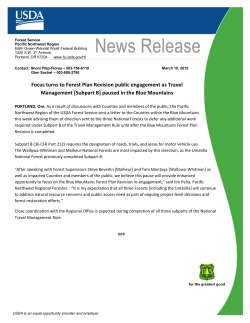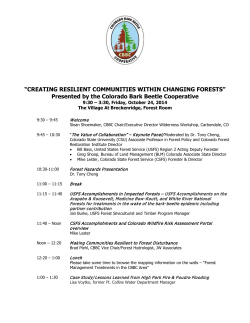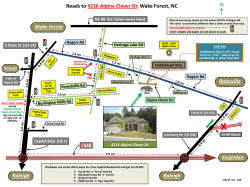
ELC Comments on Beasley Pond
April 20, 2015 Marcus Beard District Manager 57 Taff Drive Crawfordville, FL 32327 RE: Comments on Draft Environmental Impact Statement, Beasley Pond Analysis Area, Apalachicola National Forest (Liberty County, Florida). Dear Mr. Beard, On behalf of Wild South, Center for Biological Diversity, and Margaret Copeland we submit theses comments on the Draft Environmental Impact Statement (“DEIS”) for the Beasley Pond Analysis Area in the Apalachicola National Forest in Liberty County, Florida. The Forest Services identifies Alternative B as the Proposed Action/Preferred Alternative. This alternative includes among other things: • “Thinning” of approximately 2068 acres of slash and longleaf plantations or mature stands; • Implementing uneven-aged management cuts on 833 acres of longleaf pine stands; • Conducting “wet savanna restoration” treatments on 811 acres. (DEIS at 19). For the reasons explained below, the DEIS does not comply with the requirements of the National Environmental Policy Act (“NEPA”). The Forest Service’s selection of Alternative B as its preferred alternative/proposed action is arbitrary and capricious because the Forest Service fails to establish a rational connection between the facts found and the decision made. There is significant uncertainty and conflicting data regarding the historical conditions of the portion of the project area targeted for savanna restoration. Further, the impacts to the survival and recovery of Red-cockaded woodpeckers (“RCW”) could be significant and long term (particularly given that the Forest Service is impermissibly managing the species at the Managed Stability Standard) and the Forest Service has not given the necessary “hard look” at these impacts as NEPA requires. Accordingly, the Forest Service has not shown that both the restoration is necessary and that the preferred alternative will (at best) keep the RCW population “stable.” I. THE DEIS VIOLATES NEPA The DEIS runs afoul of NEPA because it fails to provide sufficient support for the Forest Service’s decision to select Alternative B as its preferred alternative, and fails to adequately consider and analyze the project’s effects (particularly the long-term, generational effects) to Red-cockaded woodpeckers. A. The Forest Service’s Selection of Alternative B as the Preferred Alternative is Arbitrary and Capricious Because the Agency Has Failed to Examine the Relevant Data and Articulate a Satisfactory Explanation for its Action. 1. There is Not Sufficient Scientific Support for the Forest Service’s Proposed 811-Acre Wet Savanna Restoration Treatment. A central tenant of federal administrative law under the Administrative Procedure Act is that agencies must examine the relevant data and articulate a satisfactory explanation for their actions, including a rational connection between the facts found and the choice made. 1 The DEIS contains incomplete and conflicting information regarding the historical condition of the Beasley Pond site and the Forest Service fails to articulate a satisfactory explanation for its decision to thin the 811-acre site down to a BA of 10-30 at the expense of as many as 35 RCW colonies that use the area for breeding and foraging habitat. See Biological Assessment at 12. The DEIS states that the Beasley Pond Analysis Area includes large areas of savanna and that many savannas throughout the region have been lost to plantation silviculture, and, in unplanted areas, alteration of fire regimes have led to the loss of wet prairies through encroachment of shrubs. DEIS at 4. The DEIS discusses a project the National Forests in Florida initiated with the Florida Natural Areas Inventory (FNAI) in 2010 to identify and delineate historical natural communities of the Apalachicola National Forest. According to the Forest Service, this investigation showed that “many historical wet savannas have been converted to forests and that a distinct natural community (upland pine) has not been previously recognized in the project area.” DEIS at 6. The Forest Service then summarily concludes that the 811- acre “restoration” project area was historically a wet savanna. There is no specific data and analysis, however, demonstrating that the 811 acres included in the preferred alternative are historically savanna areas that have been converted to forests in recent decades, nor is there data and analysis supporting the agency’s decision to “restore” it to a mostly treeless, open state with a BA of 10-30 1 Motor Vehicle Mfrs. Ass’n v. State Farm Mut. Auto. Ins. Co., 463 U.S. 29, 43 (1983). 2 square feet per acre. The DEIS states that FNAI biologists generated a GIS-based historical community map of the entire forest based on multiple years of georeferenced aerial photography, soil surveys, LiDAR digital elevation models, vegetation plots, element occurrences of rare species and natural communities and ground-truthed GPS points. But it is entirely unclear to what extent some or all of these tools were specifically employed in the Beasley Pond Area, when they were employed, and how they were employed. What was the methodology? What did the soil surveys reveal? Was there ground-truthing in the 811-acre site identified in the proposed action? In fact, the Forest Service’s reliance on one of these tools--aerial photography--contradicts its very own conclusions about the historical conditions of the 811-acre site. On page 13 of the DEIS the Forest Service explains that historical aerial photographs of the area from the early 1950s show an open vegetation structure with expansive treeless areas interspersed among forests of widely spaced pines with denser vegetation along drains. But the agency concedes that “this photograph was taken after decades of logging, turpentine extraction, grazing and intentional burning.” The Forest Service then concludes: “As such it likely depicts conditions with fewer and smaller trees than were present before European settlement of the area.” These photos and the explanation given by the Forest Service for the absence of trees in the area point to a historical condition that is inconsistent with the Forest Service’s conclusion that the site is historically an open, mostly treeless savanna. That the Apalachicola Forest Plan does not include restoration objectives for wet savannas because of “uncertainty regarding their previous geographic extent and questions about appropriate restoration activities” (DEIS at 5-6) is further telling.2 The Forest Service notes on page 16 that the “desired conditions” for such areas are not clearly defined in the Forest Plan and there are no habitat-specific restoration objectives for these areas. Thus, even if there was adequate support for concluding that these 811 acres were historically wet savannas the Forest Service is more or less left guessing at this point as to what the specific restoration activities and objectives should be and what the desired condition should look like. What are the agency’s plans when it comes to the hydrology of the region? Nowhere does the DEIS explain how it will maintain the hydrology necessary to support a wet savanna in these areas. Moreover, the Forest Service’s fire plans need to be reexamined. Regardless of what logging activities are ultimately pursued in this area (and Compartment 28 most notably) burns need to be conducted later (in summer) to simulate the timing and frequency of natural fires. This would help ensure that fires come after RCW chicks have fledged from their nest and the frosted flatwoods salamander has completed its breeding season. Given the great deal of uncertainty and support for the agency’s conclusions, the lack of any real guidance and direction regarding the activities that should be employed and the desired future conditions, and the substantial risk posed to the federally endangered Red-cockaded woodpecker (as explained below), the Forest Service has 2 It also appears the project identified in preferred alternative would be inconsistent with the Forest Plan. Under the National Forest Management Act, site-specific Forest Service projects must be consistent with that forest’s Land and Resource Management Plan (“LRMP”). 16 U.S.C. § 1604(i); 36 C.F.R. § 219.10(e). 3 failed to articulate a satisfactory explanation for going forward with its preferred alternative.3 2. The DEIS Fails to Adequately Analyze the Proposed Project’s Direct, Indirect, and Cumulative Impacts to RCWs. “NEPA imposes procedural requirements designed to force agencies to take a ‘hard look' at [the] environmental consequences” of their actions. Earth Island Inst. v. United States Forest Serv., 351 F.3d 1291, 1300 (9th Cir. 2003). “This includes considering all foreseeable direct and indirect impacts.” Id. See also 40 C.F.R. § 1508.25 (c). This DEIS fails to consider a wide range of foreseeable direct and indirect impacts on the Red-cockaded woodpecker. a. Direct Impacts The DEIS fails to fully account for direct impacts of the Proposed Action (Alternative B) on the RCW and its habitat. The DEIS states that the target BA for the first or intermediate thinning of approximately 2,068 acres of slash and longleaf pine stands and uneven-aged management cuts on 891 acres of mature longleaf pine would be 50 square feet per acre. Neither the DEIS nor the Biological Assessment explains whether this BA is adequate for the recovery of the species as required under the ESA. A higher BA may be more appropriate, particularly if a BA as low as 10-30 is being called for in those areas slated for “wet savanna restoration treatments.” Moreover, the DEIS does not identify the age and size of those trees to be thinned. These stands are 24 to 141 years old. Will the resulting project have a BA of 50 with mostly mature trees remaining or will the project simply thin larger trees to the point that the remaining smaller trees yield the same overall basal area? Obviously, the harvesting of 60, 70, 80 year old trees (and older) to get to a basal area of 50 compared to the thinning of smaller, less mature trees carries with it potentially far greater impacts in terms of foraging and possibly future nesting opportunities. Yet, none of this is examined in the DEIS. With some 35 active RCW clusters with foraging partitions in the project area the potential direct 3 At the very least, more study is required of the historic conditions of these sites and the appropriate restoration activities before project level decisions are made to alter existing ecological conditions. “[T]he very purpose of NEPA’s requirement that an EIS be prepared for all actions that may significantly affect the environment is to obviate the need for []speculation by insuring that available data is gathered and analyzed prior to the implementation of the proposed action.” Foundation for N. Am. Wild Sheep v. U.S. Dep’t of Agric., 681 F.2d 1172, 1179 (9th Cir. 1982). See also, Cabinet Res. Group v. U.S. Fish and Wildlife Serv., 465 F.Supp.2d 1067, 1100 (D. Mt. 2006) (finding that agency’s failure “to attempt any assessment of the importance of the missing information calls into question the validity of the [agency’s] conclusions about the impacts of the proposed action” and setting aside the EIS). 4 impacts could be significant. The Forest Service has not fully examined these impacts as required under NEPA. b. Indirect Impacts An EIS must analyze “indirect effects,” which are caused by the action and are later in time or farther removed in distance, but are still reasonably foreseeable. 40 C.F.R. § 1508.8(b). The DEIS fails to adequately address the indirect impacts of this project. These indirect impacts include the impacts to an unspecified and unquantified number of breeding pairs that may be harmed or harassed as a result of logging and burning practices within 200 feet of cavity trees. The Forest Service states, “if seasonal hauling guidelines from the RCW Recovery Plan are relaxed as proposed (to allow heavy equipment access to wetter areas), timber harvest and associated activities may disrupt several RCW clusters during the breeding season. Therefore, implementing the proposed action is likely to adversely affect red-cockaded woodpeckers because individuals may be disturbed during nesting season.” DEIS at 66. The Forest Service may waive harvest hauling restrictions on as many as 12 clusters, according to the Biological Assessment, to conduct timber harvest and road construction operations near RCW clusters. Biological Assessment at 9, 14, Appendix B. Considering the project area should support at least 26 RCW clusters to meet the proportional contribution to the population goal, the loss of many if not all of these 12 clusters due to reproductive losses could result in the project area failing to meet the proportional contribution to the population goal and placing additional burdens on surrounding areas to compensate for these losses (if that is even possible). The DEIS fails to examine what these waivers and resulting impacts may mean for these clusters and the population as a whole, much less attempts to quantify just how many RCWs could be impacted in these 12 clusters. There is also no attempt to extrapolate what the resulting losses could mean over the long-term. How many breeding pairs and helpers are in the area? What are their ages? How frequently have these birds reproduced? The Forest Service’s determination that the waiver of harvest hauling restrictions in “some clusters” is likely to only have shortterm (i.e., one or two years) negative effects on RCWs due to disturbance during the breeding season (DEIS at 67) lacks explanation and is without support given that the loss of even one or two years of breeding seasons could have long-term generational impacts that well exceed the 1-2 years of actual logging activities. While some birds may not reproduce for a year or two, others because of their age may not reproduce at all going forward.4 Others may simply abandon the area permanently and may face future reproductive challenges (particularly if they are forced to relocate due to a loss of adequate nearby foraging habitat). If birds relocate how may this impact nearby clusters (i.e. competition)? 4 See U.S. Fish & Wildlife Service, Red Cockaded Woodpecker Recovery Plan, 16 (2003) (discussing how reproductive success tends to decline as birds age). 5 It is rather astonishing that none of this is discussed in the EA or the Biological Assessment. The DEIS lacks any sort of meaningful analysis as required by NEPA and when coupled with the agency’s failure to provide adequate justification and scientific support for its plans to “restore” areas to historical savanna conditions, the document fails as a whole to provide any support for the Service’s conclusion that the project will maintain a “stable RCW population” as stated in the Service’s Purpose and Need Statement. (DEIS at 2).5 c. Cumulative Effects NEPA requires federal agencies to take a “hard look” at the cumulative effects of the proposed action. See Florida Wildlife Federation v. United States Army Corps of Eng’rs, 401 F.Supp.2d 1298 (S.D. Fla. 2005)(holding that the agency failed to take a “hard look” at the cumulative effects of the proposed action in its EA). To accomplish this, the Forest Service must not only catalogue past, present, and future projects but also assess the cumulative environmental impacts of those projects with the proposed project and analyze the additive cumulative impact of all these actions. See City of Carmel-By-TheSea v. United States Dep’t of Transportation, 123 F.3d 1142, 1160 (9th Cir. 1997) (rejecting cumulative impacts analysis that referred generally to other past projects and did not discuss the additive impacts of foreseeable future projects). Further, NEPA requires that a cumulative impacts analysis provide “some quantified or detailed information” because without such information, neither the courts nor the public can be assured that the agency took the necessary hard look at the project. Neighbors of Cuddy Mountain v. United States Forest Service, 137 F.3d 1372, 1379 (9th Cir. 1998) (stating that “very general” cumulative impacts information violates NEPA). In this instance, the Forest Service has failed to catalogue the cumulative impacts of previous (as well as future) logging projects on RCWs, including any future “savanna restoration” projects the Forest Service may have planned. For example, there is no discussion of the previous impacts to nearby and adjacent compartments 29, 67, 69, 72, and 73. Some of these compartments have reported BAs of 50, 60, or 70, while others have no BA provided. The DEIS does not discuss the impacts of these previous projects, whether the respective BAs are currently supportive of RCWs and to what extent, and whether the proposed activities included in the preferred alternative (when added to these prior projects) will have a cumulative, negative impact to the RCW. This would be particularly useful in determining whether the target BA of 50 in the “thinning” and “uneven management” cuts is supportive of the species recovery. Instead, the Forest Service appears to ignore these cumulative effects and narrows its analysis to the overall expected increase in the number of acres meeting or exceeding the MSS in the project area. Without a hard look at these cumulative impacts, it is premature for the Forest Service to conclude that the project would be overall beneficial to the species. This is particularly important given that the number of active cavity trees remaining in the 5 It is entirely unclear what “stable” means. To the extent the Forest Service’s objective is to maintain the status quo, this is inconsistent with the Endangered Species Act as we discuss in section 3 below. 6 adjoining clusters may be as low as 1-2, which seems low and indicative of an unhealthy cluster. Additional cumulative impacts include the impacts to RCWs occurring in remaining portions of the Apalachicola as well impacts to RCWs on nearby private lands. The most glaring omission in the Forest Service’s, however, continues to be consideration of the planned 11,200-acre project in the RCW Core Analysis Area6 as we identified in our scoping comments. It is simply incomprehensible why this project is not mentioned, much less discussed, in the cumulative impacts section of the DEIS. The proposed project could serve as a dangerous precedent for RCW management (particularly in the name of “wet savanna restoration”) and lead to reduced RCW population goals throughout the Southeast. For all these reasons, the Forest Service’s treatment of the cumulative effects of this project is entirely insufficient and fails to meet the requirements of NEPA. 3. The Forest Service is Impermissibly Managing RCWs Under the Managed Stability Standard. As we explained in our scoping comments, the Forest Service is required under Section 7 of the Endangered Species Act to conserve the RCW.7 Conservation is synonymous with recovery.8 Recovery does not simply mean maintaining stable habitat, as the Forest Service’s purpose and needs statement alleges. Recovery means taking the necessary measures to move the species to the point that it no longer needs the protections afforded under the ESA.9 For the RCW this means, among other things, to manage its foraging habitat under the “Recovery Standard” set forth in the 2003 Recovery Plan.10 That a federal agency must manage for recovery and assess a project’s impacts in terms of recovery is not just our position, but also the position of federal courts11 as well as the 6 See http://www.fs.usda.gov/projects/florida/landmanagement/projects 7 Section 7(a)(1) of the ESA requires all federal agencies to “utilize their authorities in furtherance of the purposes of this chapter” and to “carry[] out programs for the conservation of” listed species. 16 U.S.C. § 1536(a)(1). 8 The ESA defines “conservation” of listed species as “the use of all methods and procedures which are necessary to bring any [listed] species to the point at which the measures provided [under the ESA] are no longer necessary.” 16 U.S.C. § 1532(3). The “Endangered Species Act’s definition of conservation speaks to the recovery of a threatened or endangered species.” Sierra Club v. U.S. Fish & Wildlife Service, 245 F.3d 434, 441-42 (5th Cir. 2001). 9 “The objective of the Endangered Species Act is to enable listed species not merely to survive, but to recover from their endangered or threatened status.” Sierra Club v. U.S. Fish & Wildlife Service, 245 F.3d at 438. 10 U.S. Fish & Wildlife Service, Red Cockaded Woodpecker Recovery Plan, 187 (2003). 11 See National Wildlife Federation v. National Marine Fisheries Service, 524 F.3d 917 (9th Cir. 2008). 7 U.S. Fish & Wildlife Service.12 This is not being done here. Instead, the Forest Service is employing the Managed Stability Standard (“MSS”) to guide its first or intermediate thinning of approximately 2,068 acres of slash and longleaf pine stands and unevenmanagement cuts on 891 acres of mature longleaf pine. See DEIS at 66; Biological Assessment at 6, 16. This standard is intended for use on private lands and aimed at managing merely for the survival of the species, not its recovery.13 Further, the MSS will not even be met for at least 8 stands in the areas slated for “savanna treatments.” See Biological Assessment at 16. This is contrary to Section 7 of the ESA and the RCW Recovery Plan and would be a significant step back in the conservation of this primary core population. Accordingly, the Forest Service must reassess the proposed project and ensure that any future logging will be consistent with the Recovery Standard and in furtherance of the recovery of the species. The Forest Service must formally consult with the U.S. Fish & Wildlife Service concerning the impacts of this proposed project on threatened and endangered species and their critical habitat, to insure that the project will not jeopardize any listed species or adversely modify or destroy their critical habitat. 16 U.S.C. § 1536(a)(2). Conclusion “NEPA emphasizes the importance of coherent and comprehensive up-front environmental analysis to ensure informed decision making to the end that the agency will not act on incomplete information, only to regret its decision after it is too late to correct.” Marsh v. Oregon Natural Resources Council, 490 U.S. 360, 371 (1989). An EIS is required of an agency in order that it explores, more thoroughly than an EA, the environmental consequences of a proposed action whenever “substantial questions are raised as to whether a project may cause significant [environmental] degradation.” Blue Mts. Biodiversity Project v. Blackwood, 161 F.3d 1208, 1216 (9th Cir. 1998)(quoting Idaho Sporting Congress v. Thomas, 137 F.3d 1146, 1149 (9th Cir. 1998)). As evidenced by these comments, the DEIS fails on many accounts. There is inadequate support for the proposition that 811 acres must be clear-cut to a BA of 10-30 to “restore” historical savanna conditions. The DEIS fails to adequately examine the direct, indirect, and cumulative impacts of all of its thinning, uneven aged management, and savanna treatment activities, and the Forest Service is impermissibly managing RCWs under the ESA to simply maintain the species’ survival (perhaps) rather than advance its recovery. The Service should abandon its preferred alternative and manage the Beasley Pond area in a manner that does not take potentially a dozen or more clusters of RCWs. Thank you for the opportunity to comment on this proposal. Please make these comments part of the official record for this project. Also, please send me all future notices for this project. 12 See RCW Recovery Plan at 187. 13 See id. Whether the MSS actually does ensure population maintenance is debatable. 8 Sincerely, Jason Totoiu 9
© Copyright 2025









